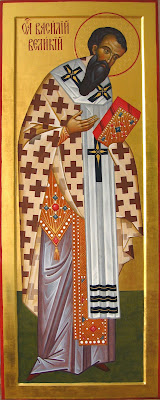Eustathios of
Sebastia introduced monasticism to Asia Minor; he influenced St. Basil, who
borrowed whatever was good in his innovations, including the monastic garments,
monastic vows, and the special religious service (tonsure) that indicated the
special status of a monk, superior to that of lay people, and subordinate to
the clergy.
 Among the many
ascetical works of St. Basil, two are the most significant in terms of
regulating the life of monasticism: the "Great Rules" (Oroi Kata
Platos), and the "Brief Rules" (Oroi Kat' Epitomen). These rules
regulate the life in the cenobitic monasteries: they extol the monastic life in
common as the ideal Christian life, the "life of perfection," while
at the same time indicating the dangers of the solitary anchoretic life. St.
Basil's Rules became the Magna Carta of Monasticism, both in the East and in
the West, throughout the monastic tradition. The difference is that while in
the Christian East the anchorite spirit of St. Anthony continues to persist as
the original monastic ideal, thus at times reacting against the organized
monasticism of a Pachomian, cenobitic type promulgated by Saint Basil in the
Rules, the Christian West, after the modifications to the Basilian Rules by St.
Benedict, remains faithful to the cenobitic spirit of organized monasticism.
Among the many
ascetical works of St. Basil, two are the most significant in terms of
regulating the life of monasticism: the "Great Rules" (Oroi Kata
Platos), and the "Brief Rules" (Oroi Kat' Epitomen). These rules
regulate the life in the cenobitic monasteries: they extol the monastic life in
common as the ideal Christian life, the "life of perfection," while
at the same time indicating the dangers of the solitary anchoretic life. St.
Basil's Rules became the Magna Carta of Monasticism, both in the East and in
the West, throughout the monastic tradition. The difference is that while in
the Christian East the anchorite spirit of St. Anthony continues to persist as
the original monastic ideal, thus at times reacting against the organized
monasticism of a Pachomian, cenobitic type promulgated by Saint Basil in the
Rules, the Christian West, after the modifications to the Basilian Rules by St.
Benedict, remains faithful to the cenobitic spirit of organized monasticism.
St. Basil set
Christian perfectionism as the goal of monastic life. The monks were to
practice Christian virtues together, especially love; to practice obedience to
a spiritual father; to practice chastity and poverty, and share the common
goods of the monastery. After they achieved Christian perfection, they were
allowed to come back to the world and help others to achieve Christian
perfection. Thus, the monks had the mission of "social workers" as
well. St. Basil's institutions, especially his Basileias, which was at the same
time an orphanage, a "kitchen for the poor," and a school for the
illiterate was in practice run by monks. This was St. Basil's way of utilizing
the monastic movement to benefit the mission of the Church in the world.
Following St.
Basil's example, the Fourth Ecumenical Council of Chalcedon (451), in its
canonical legislation, placed the monastics in a given Diocese under the direct
jurisdiction of the diocesan bishop. Only this bishop can allow the foundation
of new monasteries in his diocese (Canons 4 and 8). Thus in the Orthodox Church
the possibility of the creation of monastic "Orders," as we see them
developing in the West during the Middle Ages, was once and for all eliminated.
Monasticism also
spread in the West. Its origins go back to St. Athanasios of Alexandria, who
was exiled to the West (399). His Life of St. Anthony was translated into Latin
by Evagrios of Antioch (380). Two Latin monks, Rufinus and St. Jerome, who
lived in Palestine, brought monasticism to the West when they returned, during
the second half of the 4th century. St. Ambrose of Milan (d. 395) introduced
monasticism in Northern Italy, and St. Augustine (d. 430) in Northern Africa,
whence monasticism was transplanted to Spain. St. Martin of Tours (370)
introduced monasticism into Northern France (Gaul), and St. Honoratus of Arles
into the South. St. John Cassian founded two monasteries near Marseilles (415);
he had become acquainted with monasticism in Egypt and Palestine, and was
ordained a deacon by St. John Chrysostom in Constantinople. At. St. John's
deposition, John Cassian returned to Gaul to establish monasticism there.


















CONVERSATION